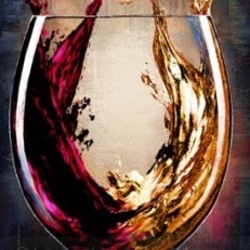Willow Way
Château Pichon Longueville Comtesse de Lalande
Pauillac Red Bordeaux Blend 1987
Such a great way to finish the night — a year ago
Bollinger
Special Cuvée Brut Champagne Blend
Love this champ!!! Wow! No headaches, not sweet. Crisp and downed way too fast. — 4 years ago
Château Pontet-Canet
Pauillac Red Bordeaux Blend 2013
Pontet Canet tasting and dinner with Alfred Tesseron.
The 13 was a brutal tannin vintage when I tasted it at En Premier. The tannins are still bitty but, nothing like they were out of barrel.
The fruit in the 13 shows the difficulty in the vintage. They are duller and it’s really stands out from other vintages and not in a good way.
It’s lean and there is nothing that really draws you in. Fruits are; dark cherries, rhubarb, blackberries, some blueberries@and the strawberries show some ripeness the other do not. Lots of dry earth, dry stones, some herbs, dark withering florals, decent acidity and a uneventful dry finish.
Photos of; Clyde and Alfred at the bar, their Amphora style cement tanks they ferment part of each vintage now, road signs of the good neighbors they keep and Chateau Pontet Canet. — 6 years ago
Louis Roederer
Cristal Brut Champagne Chardonnay Pinot Noir Blend 1990
The 1990 Cristal is remarkable. Polished, nuanced and light on its feet, the 1990 is all class. Citrus, orchard fruit and floral notes are wonderfully lifted throughout. A slight reductive note adds character on the finely knit finish. I can’t think of a better way to start this tasting. Simply put, the 1990 is a total rock star. Moreover, it is much more delicate than most wines from this ripe vintage. Amazingly, the 1990 tastes like it is still not ready! “Nineteen ninety was my second vintage here,” says Chef de Caves Jean-Baptiste Lécaillon. “It was ideal. The fruit was just perfect. We blocked the malolactic fermentation completely and only fermented 6-7% of our lots in oak, as opposed to the more typical 20%, in order to preserve as much freshness as possible. The wine was made by my predecessor, Michel Pansu, but I was learning. This was the first year I started working with oxygen by reducing sulfites in vinification to pre-oxidize the Chardonnay musts, as I do know, which allows me to get rid of all the unstable, oxidative compounds. With Pinot, on the other hand, you need a little bit of sulfur at crush or you lose the brilliant fruit. (Antonio Galloni, Vinous, December 2018) — 7 years ago
Château Cheval Blanc
St. Émilion Red Bordeaux Blend 1988
Marchesi Antinori
Tignanello Toscana Super Tuscan Blend 2016
Dark ruby color. Deep tart cherry so smooth on the way down. Wonderful wine — 5 years ago
Villa Creek Cellars
Willow Creek Cuvée Paso Robles Grenache Blend 2017
Fruity and smooth. — 6 years ago
Caymus Vineyards
Special Selection Napa Valley Cabernet Sauvignon 2014
Top 5 for me. Let it open up, so good! Way better than regular Caymus. Drinks like a big boy wine — 7 years ago
Château Mouton Rothschild
Pauillac Red Bordeaux Blend 1994
Surprising in every way. BlackBerry, menthol, grilled meats, lavender. Wonderful concentration, depth and structure. Youthful and superb. — 7 years ago
Domaine du Pegau
Cuvée Réservé Châteauneuf-du-Pape Red Rhone Blend 2004
Leathery and red floral nose. After 1 hour decant, opulent, lightly spiced and earthy-red palate infused with dried mushrooms, iron and throughout with notes of garrigue. Punching way above its weight in a meh vintage...just entering a window that will last 10+ years. — 8 years ago
Château Margaux
Premier Grand Cru Classé Margaux Red Bordeaux Blend 2009
Way to ring in the New Year! Lithe, feminine nose led a nicely delineated palate of dark red fruit, cigar box and velvety tannins. Wonderful. — 2 years ago
L'Aventure
Optimus Willow Creek District Red Blend 2019
This punches above its weight class. Having had the estate cuvée and cote bottles, this feels a peer. Big deep fruits. Smooth all the way through. Loved it — 3 years ago
Taittinger
Comtes de Champagne Grand Crus Brut Blanc de Blancs 2007
Well...this was one hell of a week. There is only one way to wind it down. Reach for an excellent bottle of vintage Champagne.
My first thoughts are how delicate this is on the palate. Further, how unbelievable it will be with another 8-10 years in bottle.
The nose shows; slightly sour lemon, the good parts of lemon Pledge, lemon meringue, white stone fruits, pineapple fresh with lots of juice, grapefruit, lime pulp, honeysuckle, soft, haunting caramel, brioche, limestone & slightly, dirty, grey volcanics, saline, sea fossils, sea spray, bread dough, vanilla, white spices-light ginger with spring flowers, mixed floral greens & lilies.
The body is light on its feet and dances on the palate. Delicacy abounds. Its soft, gorgeous mousse right there with the best money can buy. Slightly sour lemon, lemon meringue, green & with more bruised golden apple, white stone fruits, pineapple fresh with lots of juice, grapefruit, lime pulp, touch of apple cider, honeysuckle, soft, haunting caramel, ginger ale into cream soda, brioche, nougat, toffee notes, lighter nuts without skin, limestone & slightly, dirty, grey volcanics, saline, sea fossils, sea spray, bread dough, vanillin, marzipan, white spices-light ginger with spring flowers, mixed floral greens & lilies. The acidity is mellow yet lively, gorgeous and as good as it gets. The finish is all luxury. So well knitted & balanced, elegant, rich but not overpowering and gently persisting several minutes.
Photos of; The House of Taittinger, their caves so chalky white and built on the famous Crayères Cellars of Reims: 2.5 miles of tunnels (they own 1/4 to 1/3 of it) cut out of chalk by the Romans, the portrait of Thibaud IV who was a king, lord, manager, singer, conqueror, explorer & 11th century Crusader all rolled into one from which, this Cuvée was the catalyst creation and part of the 600 plus hectares they own in Champange.
Some producer notes; Taittinger's history can be traced back to 1734, when it was originally known as Forest-Fourneaux, founded by Jacques Fourneaux who worked closely with local Benedictine monks to learn how to produce wine. They were just the 3rd Champange house.
The estate was bought by the Taittingers – a family of wine merchants – in 1932, and thanks to the great depression and subsequent low land prices, the family also picked up huge swathes of vineyard. From 1945-1960, Francois Taittinger established the cellars in the Abbey of Saint-Nicaise, and after his death in 1960 his brother Claude took over, pushing the estate into a Champagne house of world renown. Such was the status of the label that the Taittinger family soon expanded its business into other luxury goods. However, this eventually led to financial difficulties, and in 2005 the Taittinger brand – including the Champagne house – was sold to the American owned Starwood Hotel Group. The sale was badly received by the Champagne industry, with many fearing the new owners – unfamiliar with the culture of Champagne – would put profit ahead of quality.
Just one year later, Claude’s nephew, Pierre-Emmanuel Taittinger, who had always been opposed to the sale, negotiated a €660m deal with the Starwood Group, and the Taittinger family resumed ownership of the company.
In 2017, Taittinger planted its first vines in England, near a village in Kent, for its venture into English sparkling wine. The first bottle will be ready in 2023.
1/8/21 — 5 years ago





















Mariana Puga
love love loveee!!!! — 9 months ago